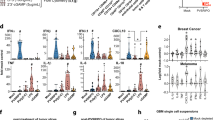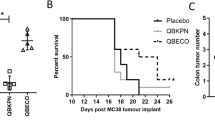Abstract
We have addressed the hypothesis that pathogen-associated immunomodulatory molecules may influence anti-tumor immunity through their pro- and anti-inflammatory activities and abilities to induce effector and regulatory T (Treg) cells. We found that CpG oligonucleotides (CpG) and cholera toxin (CT), which promote Th1 or Th2/Treg cell biased responses, respectively, had differential effects on tumor growth. Therapeutic peritumoral administration of CpG significantly reduced subcutaneous tumor growth and prolonged survival, whereas CT enhanced tumor growth and reduced survival. Peritumoral administration of CpG enhanced the frequency of IFN-γ-secreting and reduced IL-10-secreting CD4+ and CD8+ T cells, in the tumor and in the draining lymph nodes, whereas, CT significantly enhanced the frequency of CD4+CD25+Foxp3+ Treg cells, but reduced IFN-γ-secreting T cells infiltrating the tumor. In contrast to the beneficial effect of CpG in mice with subcutaneous tumors, CpG or CT had no protective effect against tumor growth in the lungs when given therapeutically by the nasal route. However, prophylactic intranasal administration of CpG significantly reduced the number of lung metastases and this was associated with an enhanced frequency of IFN-γ-secreting CD8+ T cells in the draining lymph node and enhanced tumor-specific CTL responses. Our findings demonstrate that pathogen-associated molecules can either inhibit or enhance anti-tumor immunity by selectively promoting the induction of effector or regulatory T cells, and that the environment of the growing tumor influences the protective effect.










Similar content being viewed by others
Abbreviations
- Treg :
-
Regulatory T (cell)
- CpG :
-
CpG oligonucleotide
- CT :
-
Cholera toxin
- TLR :
-
Toll-like receptor
- DC :
-
Dendritic cell
- p.t. :
-
Peritumoral
- s.c. :
-
Subcutaneous
- i.n. :
-
Intranasal
References
Meyer JP, Persad R, Gillatt DA (2002) Use of bacille Calmette-Guerin in superficial bladder cancer. Postgrad Med J 78(922):449–454
Akira S, Hemmi H (2003) Recognition of pathogen-associated molecular patterns by TLR family. Immunol Lett 85(2):85–95
Agrawal S, Agrawal A, Doughty B, Gerwitz A, Blenis J, Van Dyke T, Pulendran B (2003) Cutting edge: different Toll-like receptor agonists instruct dendritic cells to induce distinct Th responses via differential modulation of extracellular signal-regulated kinase-mitogen-activated protein kinase and c-Fos. J Immunol 171(10):4984–4989
Hemmi H, Takeuchi O, Kawai T, Kaisho T, Sato S, Sanjo H, Matsumoto M, Hoshino K, Wagner H, Takeda K, Akira S (2000) A Toll-like receptor recognizes bacterial DNA. Nature 408(6813):740–745
Tsan MF (2006) Toll-like receptors, inflammation and cancer. Semin Cancer Biol 16(1):32–37
Kunikata N, Sano K, Honda M, Ishii K, Matsunaga J, Okuyama R, Takahashi K, Watanabe H, Tamura G, Tagami H, Terui T (2004) Peritumoral CpG oligodeoxynucleotide treatment inhibits tumor growth and metastasis of B16F10 melanoma cells. J Invest Dermatol 123(2):395–402
Heckelsmiller K, Rall K, Beck S, Schlamp A, Seiderer J, Jahrsdorfer B, Krug A, Rothenfusser S, Endres S, Hartmann G (2002) Peritumoral CpG DNA elicits a coordinated response of CD8 T cells and innate effectors to cure established tumors in a murine colon carcinoma model. J Immunol 169(7):3892–3899
Krieg AM (2006) Therapeutic potential of Toll-like receptor 9 activation. Nat Rev Drug Discov 5(6):471–484
Kasahara K, Shibata K, Shintani H, Iwasa K, Sone T, Kimura H, Nobata K, Hirose T, Yoshimi Y, Katayama N, Ishiura Y, Kita T, Nishi K, Nakatsumi Y, Ryoma Y, Fujimura M, Nakao S (2006) Randomized phase II trial of OK-432 in patients with malignant pleural effusion due to non-small cell lung cancer. Anticancer Res 26(2B):1495–1499
Evans JT, Cluff CW, Johnson DA, Lacy MJ, Persing DH, Baldridge JR (2003) Enhancement of antigen-specific immunity via the TLR4 ligands MPL adjuvant and Ribi.529. Expert Rev Vaccines 2(2):219–229
Hadley G, Derry S, Moore RA (2006) Imiquimod for actinic keratosis: systematic review and meta-analysis. J Invest Dermatol 126(6):1251–1255
Lavelle EC, McNeela E, Armstrong ME, Leavy O, Higgins SC, Mills KH (2003) Cholera toxin promotes the induction of regulatory T cells specific for bystander antigens by modulating dendritic cell activation. J Immunol 171(5):2384–2392
Han X, Papadopoulos AJ, Jones T, Devaja O, Raju KS (1999) Cholera toxin-induced alteration of the phenotype and behaviour of an ovarian carcinoma cell line, SR8. Immunol Cell Biol 77(5):377–384
Eriksson K, Sun JB, Nordstrom I, Fredriksson M, Lindblad M, Li BL, Holmgren J (2004) Coupling of antigen to cholera toxin for dendritic cell vaccination promotes the induction of MHC class I-restricted cytotoxic T cells and the rejection of a cognate antigen-expressing model tumor. Eur J Immunol 34(5):1272–1281
Huang M, Stolina M, Sharma S, Mao JT, Zhu L, Miller PW, Wollman J, Herschman H, Dubinett SM (1998) Non-small cell lung cancer cyclooxygenase-2-dependent regulation of cytokine balance in lymphocytes and macrophages: up-regulation of interleukin 10 and down-regulation of interleukin 12 production. Cancer Res 58(6):1208–1216
Ko K, Yamazaki S, Nakamura K, Nishioka T, Hirota K, Yamaguchi T, Shimizu J, Nomura T, Chiba T, Sakaguchi S (2005) Treatment of advanced tumors with agonistic anti-GITR mAb and its effects on tumor-infiltrating Foxp3+CD25+CD4+ regulatory T cells. J Exp Med 202(7):885–891
Jarnicki AG, Lysaght J, Todryk S, Mills KHG (2006) Suppression of antitumor immunity by IL-10 and TGF-beta-producing T cells infiltrating the growing tumor: influence of tumor environment on the induction of CD4+ and CD8+ regulatory T cell. J Immunol 177(2):896–904
Smyth JW, Fleeton MN, Sheahan BJ, Atkins GJ (2005) Treatment of rapidly growing K-BALB and CT26 mouse tumours using Semliki Forest virus and its derived vector. Gene Ther 12(2):147–159
Mills KH (1996) Induction and detection of T cell responses. In: Robinson A, Farrar GH, Wiblin CN (eds) Methods in molecular medicine. Vaccine protocols. Humana Press, Totwa, pp 197–222
Krieg AM (2002) CpG motifs in bacterial DNA and their immune effects. Annu Rev Immunol 20:709–760
Lonsdorf AS, Kuekrek H, Stern BV, Boehm BO, Lehmann PV, Tary-Lehmann M (2003) Intratumor CpG-oligodeoxynucleotide injection induces protective antitumor T cell immunity. J Immunol 171(8):3941–3946
Gough M, Crittenden M, Thanarajasingam U, Sanchez-Perez L, Thompson J, Jevremovic D, Vile R (2005) Gene therapy to manipulate effector T cell trafficking to tumors for immunotherapy. J Immunol 174(9):5766–5773
Ohmura E, Wakai K, Isozaki O, Murakami H, Onoda N, Emoto N, Shizume K, Tsushima T, Demura H, Robins RK (1993) Inhibition of human pancreatic cancer cell (MIA PaCa-2) growth by cholera toxin and 8-chloro-cAMP in vitro. Br J Cancer 67(2):279–283
Sun JB, Eriksson K, Li BL, Lindblad M, Azem J, Holmgren J (2004) Vaccination with dendritic cells pulsed in vitro with tumor antigen conjugated to cholera toxin efficiently induces specific tumoricidal CD8+ cytotoxic lymphocytes dependent on cyclic AMP activation of dendritic cells. Clin Immunol 112(1):35–44
Bui JD, Uppaluri R, Hsieh CS, Schreiber RD (2006) Comparative analysis of regulatory and effector T cells in progressively growing versus rejecting tumors of similar origins. Cancer Res 66(14):7301–7309
Golgher D, Jones E, Powrie F, Elliott T, Gallimore A (2002) Depletion of CD25+ regulatory cells uncovers immune responses to shared murine tumor rejection antigens. Eur J Immunol 32(11):3267–3275
Higgins SC, Lavelle EC, McCann C, Keogh B, McNeela E, Byrne P, O’Gorman B, Jarnicki A, McGuirk P, Mills KH (2003) Toll-like receptor 4-mediated innate IL-10 activates antigen-specific regulatory T cells and confers resistance to Bordetella pertussis by inhibiting inflammatory pathology. J Immunol 171(6):3119–3127
Porgador A, Staats HF, Faiola B, Gilboa E, Palker TJ (1997) Intranasal immunization with CTL epitope peptides from HIV-1 or ovalbumin and the mucosal adjuvant cholera toxin induces peptide-specific CTLs and protection against tumor development in vivo. J Immunol 158(2):834–841
Acknowledgments
This work was supported by a Science Foundation Ireland Principal Investigator Award (no. 00/PI.I/B045 to K.H.G. Mills).
Author information
Authors and Affiliations
Corresponding author
Additional information
Joanne Lysaght and Andrew G. Jarnicki contributed equally.
Rights and permissions
About this article
Cite this article
Lysaght, J., Jarnicki, A.G. & Mills, K.H.G. Reciprocal effects of Th1 and Treg cell inducing pathogen-associated immunomodulatory molecules on anti-tumor immunity. Cancer Immunol Immunother 56, 1367–1379 (2007). https://doi.org/10.1007/s00262-007-0288-1
Received:
Accepted:
Published:
Issue Date:
DOI: https://doi.org/10.1007/s00262-007-0288-1




